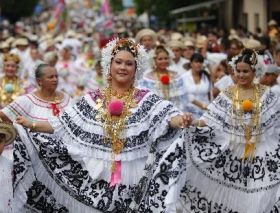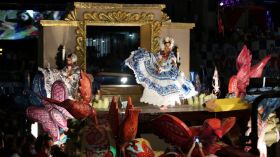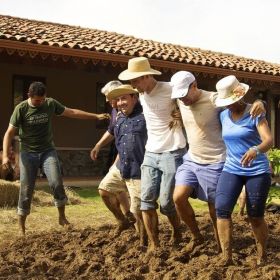What are the traditions of Panama?
Col Davis Stevenson RET
Probably the greatest tradicion / tradition in Panama is Carnival, which is taken very seriously and lasts the better part of a week, with the final evening of festivities lasting into the we hours of the morning. One day of Carnival is a day when you have a pretty good chance of being soaked with water with all of the population busy tossing buckets of water on you. One great tradition of Carnival in Panama is the Carnival Festivities in the Azuero-Chitre area where the ladies dress in...
Probably the greatest tradicion / tradition in Panama is Carnival, which is taken very seriously and lasts the better part of a week, with the final evening of festivities lasting into the we hours of the morning. One day of Carnival is a day when you have a pretty good chance of being soaked with water with all of the population busy tossing buckets of water on you. One great tradition of Carnival in Panama is the Carnival Festivities in the Azuero-Chitre area where the ladies dress in the traditional Pollera and parade up and down the streets. During Carnival dance halls are built in public places where there is a constant party, mostly referred to as PINDINGs. Traditional foods are sold by vendors: carne en palito ("meat on the stick), carimanolas, Fried Yucca and tortillas, naturally all being washed down with SECO, a fiery drink distilled from sugar cane.
Posted April 16, 2013
Nelson Vega
The "Pollera" is the national female  traditional custom dress (one of the most beautiful, and quite expensive too). If you'd like to experience the traditions of Panama all together in one place then you should go to the Desfile de las Mil Polleras (One Thousand Polleras Parade). It takes place every year in the city of Las Tablas, province of Los Santos. During this event you will experience a big part of our traditional culture like food, music, dance, national...
traditional custom dress (one of the most beautiful, and quite expensive too). If you'd like to experience the traditions of Panama all together in one place then you should go to the Desfile de las Mil Polleras (One Thousand Polleras Parade). It takes place every year in the city of Las Tablas, province of Los Santos. During this event you will experience a big part of our traditional culture like food, music, dance, national...
 traditional custom dress (one of the most beautiful, and quite expensive too). If you'd like to experience the traditions of Panama all together in one place then you should go to the Desfile de las Mil Polleras (One Thousand Polleras Parade). It takes place every year in the city of Las Tablas, province of Los Santos. During this event you will experience a big part of our traditional culture like food, music, dance, national...
traditional custom dress (one of the most beautiful, and quite expensive too). If you'd like to experience the traditions of Panama all together in one place then you should go to the Desfile de las Mil Polleras (One Thousand Polleras Parade). It takes place every year in the city of Las Tablas, province of Los Santos. During this event you will experience a big part of our traditional culture like food, music, dance, national... The "Pollera" is the national female  traditional custom dress (one of the most beautiful, and quite expensive too). If you'd like to experience the traditions of Panama all together in one place then you should go to the Desfile de las Mil Polleras (One Thousand Polleras Parade). It takes place every year in the city of Las Tablas, province of Los Santos. During this event you will experience a big part of our traditional culture like food, music, dance, national customs, and the way residents of the countryside of Panama like to party and Celebrate.
traditional custom dress (one of the most beautiful, and quite expensive too). If you'd like to experience the traditions of Panama all together in one place then you should go to the Desfile de las Mil Polleras (One Thousand Polleras Parade). It takes place every year in the city of Las Tablas, province of Los Santos. During this event you will experience a big part of our traditional culture like food, music, dance, national customs, and the way residents of the countryside of Panama like to party and Celebrate.
 traditional custom dress (one of the most beautiful, and quite expensive too). If you'd like to experience the traditions of Panama all together in one place then you should go to the Desfile de las Mil Polleras (One Thousand Polleras Parade). It takes place every year in the city of Las Tablas, province of Los Santos. During this event you will experience a big part of our traditional culture like food, music, dance, national customs, and the way residents of the countryside of Panama like to party and Celebrate.
traditional custom dress (one of the most beautiful, and quite expensive too). If you'd like to experience the traditions of Panama all together in one place then you should go to the Desfile de las Mil Polleras (One Thousand Polleras Parade). It takes place every year in the city of Las Tablas, province of Los Santos. During this event you will experience a big part of our traditional culture like food, music, dance, national customs, and the way residents of the countryside of Panama like to party and Celebrate. This year the Desfile de las Mil Polleras will take place on Saturday, January 12th.
Posted January 3, 2014
Lourdes Townshend
The traditions in the Republic of Panamá vary from place to place. But I must say that our most important tradition is our people; warm and friendly, with a willingness to share their history, culture and all the good things Panamá has to offer.
Probably one of the best kept traditions is our national dress, handed down from generation to generation with great pride. A good proof of this is our annual "Mil Polleras...
The traditions in the Republic of Panamá vary from place to place. But I must say that our most important tradition is our people; warm and friendly, with a willingness to share their history, culture and all the good things Panamá has to offer.
Probably one of the best kept traditions is our national dress, handed down from generation to generation with great pride. A good proof of this is our annual "Mil Polleras Parade", celebrated every year in January. This year, it will be held on January 12, 2014. During this parade you will see Panamanian ladies gathered together Las Tablas, Panamá, from every corner of the planet, in order to compete for the best and most complete dress. Some of thse dresses are over 100 years old, but they are very well preserved.
The folkloric music is another wonderful tradition, and since childhood, children learn different ways of expressing themselves, as the "tonadas", among many others. The province of Azuero has the best example for folkloric traditions.
There are Panamámanian traditions like desserts, of which the "sopa borracha" represents an icon at weddings; the famous "sancocho" (soup chicken with culantro and ñame) and many other Panamanian recipes that citizens living abroad miss so much in their daily meals.
Another tradition is a weekend get together, mainly in the country ("interior"). Sometimes, especially in times like carnival, Holy Week, independence day, or any long weekend or holidays, it is almost mandatory to head for your second home at the beach, bringing with you some family members, friends, or your children´s friends.
A good tradition, though, is to welcome visitors and be proud of showing every detail about the country.
Posted January 11, 2014
Rosario Townshend - Multimodal & Logistic Transports Magazine
The traditions of Panamá are a combination of the traditions of several nationalities that came to Panamá for the construction of canal, when each one brought their unique traditions, many of which remain to this day. Therefore, when we talk about traditions in Panamá, we are talking about a wide range, with many different nationalities contributing.
We just celebrated the Afro Ethnic Group Month. Many ethnic Africans have made great...
We just celebrated the Afro Ethnic Group Month. Many ethnic Africans have made great...
The traditions of Panamá are a combination of the traditions of several nationalities that came to Panamá for the construction of canal, when each one brought their unique traditions, many of which remain to this day. Therefore, when we talk about traditions in Panamá, we are talking about a wide range, with many different nationalities contributing.
We just celebrated the Afro Ethnic Group Month. Many ethnic Africans have made great contributions to the culture and history of Panamá.
We also have great Jewish and Greek communities, with beautiful and deep values and customs.
There is the Chinese community, that for years had developed tremendous programs, not only cultural, but medical as well.
And these are only a few, but Panamá is very fortunate to have so many people from other countries who have contributed a great deal to develop Panamá. Of course, these people are no longer foreigners. For generations now they are 100% Panamanian, with authentic reasons to love this country, while at the same time, preserving the traditions of the places from which they came.
There are Italian, Spanish, Norwegian, Japanese, Portuguese, Palestinian, Asian Indian, Pakistani, Arabic, and so many other communities involved in trade, commerce, maritime, and many other occupations and endeavors that enrich Panamá.
Talking about traditions, we can mention our folkloric festivals, not only in the city of Panamá, but in the "interior" (countryside) as well. Places like Las Tablas, Chitré, Los Santos, and Penonomé are some examples of areas that host several of the main festivals for years, like the 1,000 polleras (national dress) parade in January, or the "Torito Guapo", the "Congo" (Portobelo), the "Diablitos Sucios" and so many others.
We just celebrated the Afro Ethnic Group Month. Many ethnic Africans have made great contributions to the culture and history of Panamá.
We also have great Jewish and Greek communities, with beautiful and deep values and customs.
There is the Chinese community, that for years had developed tremendous programs, not only cultural, but medical as well.
And these are only a few, but Panamá is very fortunate to have so many people from other countries who have contributed a great deal to develop Panamá. Of course, these people are no longer foreigners. For generations now they are 100% Panamanian, with authentic reasons to love this country, while at the same time, preserving the traditions of the places from which they came.
There are Italian, Spanish, Norwegian, Japanese, Portuguese, Palestinian, Asian Indian, Pakistani, Arabic, and so many other communities involved in trade, commerce, maritime, and many other occupations and endeavors that enrich Panamá.
Talking about traditions, we can mention our folkloric festivals, not only in the city of Panamá, but in the "interior" (countryside) as well. Places like Las Tablas, Chitré, Los Santos, and Penonomé are some examples of areas that host several of the main festivals for years, like the 1,000 polleras (national dress) parade in January, or the "Torito Guapo", the "Congo" (Portobelo), the "Diablitos Sucios" and so many others.
Panamá has unique places and churches, like "Natá de los Caballeros", and cultural centers in Chiriquí and other provinces. We can also mention our native groups, with each one having their unique style, located in Chiriquí/Bocas del Toro, Veraguas and Darién. Each one provides invaluable traditions and culture.
If we consider traditions in gastronomy, we can mention "arroz con pollo" (rice and chicken), "plátano en tentación" (yellow plantain), "ceviche "(fish), potato or beet and chayote salad. And what can we say about the numerous desserts with great names? One of the best known is the "sopa borracha" (drunk soup), which is served in weddings.
And of course, we have the typical foods that can´t missed when you visit Panamá, or requested by locals at any restaurant, including the "tortilla", "empanada", "hojaldre", or "carimañola" (made out of yuca). But there is also the popular "chichas", which are fresh fruits beverages made right in front of you.
What about daily traditions? Panamanians love to entertain themselves and go out to eat on a regular basis. Panamanians have family get-togethers every weekend, engage in internal tourism, go to their beach or mountain houses to have relaxing days, and have fun; things that foreigners had adapted very well, and enjoy doing along with everyone else.
One of the traditions in Panamá is certainly the carnival. Locals will not tolerate not to have fun this week. Others either gather in the fun, or take this opportunity to go away on a trip.
Posted June 8, 2014
José Martínez - Two Oceans Property Consultants S.A.
Panamanians from their ancestors have rolling five indigenous cultures that took shape before the stage marked by Cristobal Colon.
From the sixteenth century with the arrival of the Spaniards began to be operated transformations compounded by the subsequent presence of African descent and to a lesser extent in terms of legacy are the Chinese, French and Americans who also enriched the heritage of country music and art.
The...
Panamanians from their ancestors have rolling five indigenous cultures that took shape before the stage marked by Cristobal Colon.
From the sixteenth century with the arrival of the Spaniards began to be operated transformations compounded by the subsequent presence of African descent and to a lesser extent in terms of legacy are the Chinese, French and Americans who also enriched the heritage of country music and art.
The variety is huge and dance among them are the so-called Great Devil symbolizing the struggle between good and grave evil, represented in the figures of Saint Michael the Archangel and the Devil respectively.
Likewise is the Pajarilla manifestation cultivated by the inhabitants of San José de Las Tablas and is one of the festivals of Corpus.
The Montezuma in their Spanish versions Cabezona has been in effect in populations of Azuero, especially in La Villa de Los Santos.
El Torito is considered as a famous and joyful dance. It also added that of Cucuas, Dirty Diablos and Diablos Mirrors.
The country has a rich variety of legends that are told mainly in inland villages, where can mention Warrior Lady or Margarita Champs and jet Mozas Luisita Patiño Aguilera, the Black Snapper Manuel María Alba, La Niña Encantada Leaping pylon Sergio González Ruiz.
The most notable festivals are the employers, on Holy Saturday, the Day of the Cross, Marjoram Festival, Festival of the Pollera, San Sebastián in Ocu, Corpus Christi and other interesting peculiarities.

Posted June 24, 2014
Maria Amelia Pezzotti
 We have different holidays all over the country of Panama.
We have different holidays all over the country of Panama. Specifically in Chitré in the Azuero Peninsula, we have holidays such as Holy Week where there are presentations of the holy birth.
During national holidays, ladies wear polleras, which is the traditional dress of Panamanian women. For many years, polleras were being sold by grandmothers and old ladies from the small towns. Some put jewelry on the polleras such as...
 We have different holidays all over the country of Panama.
We have different holidays all over the country of Panama. Specifically in Chitré in the Azuero Peninsula, we have holidays such as Holy Week where there are presentations of the holy birth.
During national holidays, ladies wear polleras, which is the traditional dress of Panamanian women. For many years, polleras were being sold by grandmothers and old ladies from the small towns. Some put jewelry on the polleras such as gold, turquoise, pearls, and many other different gems. Polleras are sold in many different colors and designs. The craftsmanship are of different techniques as well. We also wear tembleques, which is a head ornament worn by women when they wear polleras. Some tembleques are even made of fish scales. They don’t smell because they were treated but they are made of real fish scales. You will see the great craftsmanship of Panamanians when you see these polleras and tembleques.
Aside from national holidays, we also use polleras during a holiday in January. You will see more than a thousand women wearing polleras. Traditionally, the gala polleras or the elegant polleras were used in parties and weddings. When women work in the fields or just at home taking care of the children, they use another kind of pollera, which is a less elegant pollera made of a different material. And they don’t use tembleques at home. Nowadays, we don’t wear polleras to a wedding anymore unless the wedding is a typical Panamanian wedding. If the bride wants to get married in a traditional Panamanian way, she would wear a gala pollera.
Another tradition of Panama is the Junta de Embarre, which is when people from the community gather and build a house made of clay. They step on clay and they get all dirty with it. They dance around the clay and they build the house. In Chitré and in Azuero as well, there are several communities that are making Juntas de Embarre. The whole community gathers to build a house for a fellow neighbor. This is a tradition that is still being done in the small towns and we are trying to save that tradition because people in the mountains do live in these houses that are made of clay. However, in the cities and in the developments, this is not being done anymore. In Cubitá, we take our guests for a tour and show them how a Junta de Embarre is done.
(Cubita Development staff building a clay house the traditional way, Azuero, Panama, pictured.)
Posted April 27, 2016


